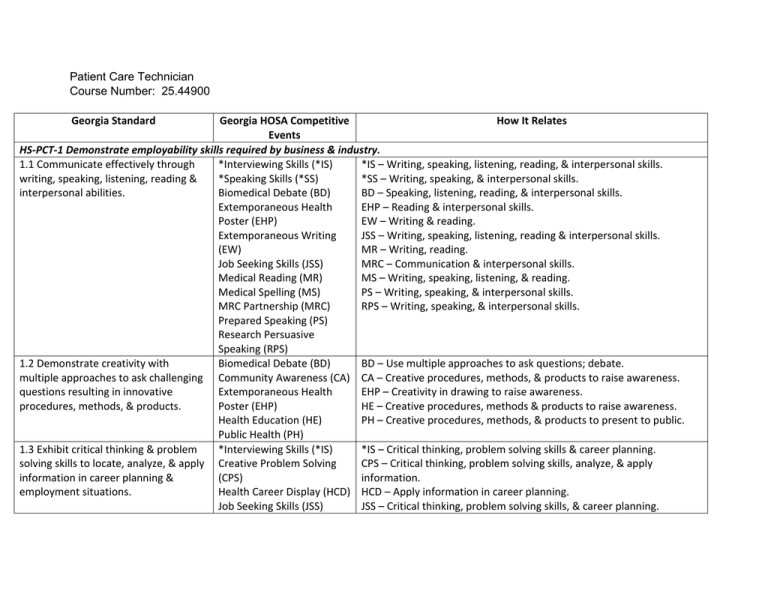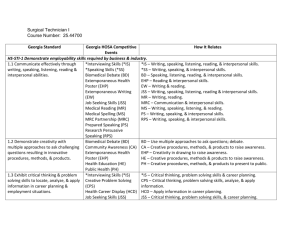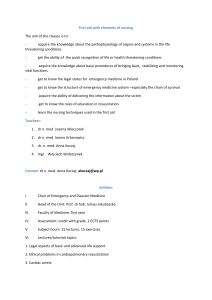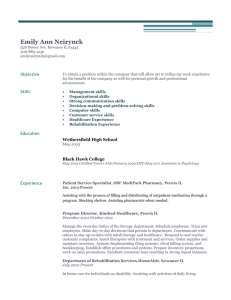Patient Care Technician
advertisement

Patient Care Technician Course Number: 25.44900 Georgia Standard Georgia HOSA Competitive How It Relates Events HS-PCT-1 Demonstrate employability skills required by business & industry. 1.1 Communicate effectively through *Interviewing Skills (*IS) *IS – Writing, speaking, listening, reading, & interpersonal skills. writing, speaking, listening, reading & *Speaking Skills (*SS) *SS – Writing, speaking, & interpersonal skills. interpersonal abilities. Biomedical Debate (BD) BD – Speaking, listening, reading, & interpersonal skills. Extemporaneous Health EHP – Reading & interpersonal skills. Poster (EHP) EW – Writing & reading. Extemporaneous Writing JSS – Writing, speaking, listening, reading & interpersonal skills. (EW) MR – Writing, reading. Job Seeking Skills (JSS) MRC – Communication & interpersonal skills. Medical Reading (MR) MS – Writing, speaking, listening, & reading. Medical Spelling (MS) PS – Writing, speaking, & interpersonal skills. MRC Partnership (MRC) RPS – Writing, speaking, & interpersonal skills. Prepared Speaking (PS) Research Persuasive Speaking (RPS) 1.2 Demonstrate creativity with Biomedical Debate (BD) BD – Use multiple approaches to ask questions; debate. multiple approaches to ask challenging Community Awareness (CA) CA – Creative procedures, methods, & products to raise awareness. questions resulting in innovative Extemporaneous Health EHP – Creativity in drawing to raise awareness. procedures, methods, & products. Poster (EHP) HE – Creative procedures, methods & products to raise awareness. Health Education (HE) PH – Creative procedures, methods, & products to present to public. Public Health (PH) 1.3 Exhibit critical thinking & problem *Interviewing Skills (*IS) *IS – Critical thinking, problem solving skills & career planning. solving skills to locate, analyze, & apply Creative Problem Solving CPS – Critical thinking, problem solving skills, analyze, & apply information in career planning & (CPS) information. employment situations. Health Career Display (HCD) HCD – Apply information in career planning. Job Seeking Skills (JSS) JSS – Critical thinking, problem solving skills, & career planning. MRC Partnership (MRC) 1.4 Model work readiness traits required for success in the workplace including integrity, honesty, accountability, punctuality, time management, & respect for diversity. 1.5 Apply the appropriate skill sets to be productive in a changing, technological, & diverse workplace to be able to work independently, interpret data, & apply teamwork skills. *Interviewing Skills (*IS) *Speaking Skills (*SS) Conference Dress Code Job Seeking Skills (JSS) Prepared Speaking (PS) Researched Persuasive Speaking (RPS) Biomedical Debate (BD) Community Awareness (CA) Creative Problem Solving (CPS) Forensic Medicine (FM) Health Career Display (HCD) Health Education (HE) HOSA Bowl (HB) Knowledge Test: Transcultural Health Care (KT-THC) Medical Innovation (MI) Parliamentary Procedures (PP) Public Service Announcement (PSA) All Competitive Events Conference Dress Code MRC – Critical thinking, problem solving skills, apply information for career planning, & employment situations. *IS – Model work readiness traits. *SS – Model work readiness traits. Conference dress code models work readiness traits. JSS – Model work readiness traits. PS – Model work readiness traits. RPS – Model work readiness traits. BD – Diversity, interpret data, & apply teamwork. CA – Diversity, interpret data, & apply teamwork. CPS – Interpret data & apply teamwork. FM – Interpret data & apply teamwork. HCD – Interpret data & apply teamwork. HE – Diversity, apply teamwork. HB – Interpret data & apply teamwork. KT-THC – Diversity within workplace. MI – Technological environment, interpret data, & apply teamwork. PP – Interpret data & apply teamwork. PSA – Technological environment & apply teamwork. 1.6 Present a professional image Dress code requires students to be in a navy blue or black suit at all through appearance, behavior, & times. language. HS-PCT-2 Demonstrate professional demeanor at all times, both in the classroom and within the healthcare facilities. 2.1 Understand and demonstrate All Standards Competitive events requires professional demeanor at all times dependability relating to being present, on time, and ready to participate. 2.2 Understand and demonstrate All Standards Competitive events requires professional demeanor at all times compassion relating to being sensitive to the needs of patients and coworkers. 2.3 Understand and demonstrate All Standards Competitive events requires professional demeanor at all times flexibility relating to willingness to adapt to changes, accept added responsibility, and be a team player 2.4 Understand and demonstrate All Standards Competitive events requires professional demeanor at all times honesty relating to willingness to admit mistakes, to get help when unsure of a procedure, and to act in the interest of client safety. 2.5 Understand and demonstrate All Standards Competitive events requires professional demeanor at all times integrity relating to client privacy and client confidentiality. 2.6 Understand and demonstrate the All Standards Competitive events requires professional demeanor at all times importance of personal appearance to include appropriate dress code, good personal hygiene, and professional demeanor. 2.7 Understand and demonstrate the All Standards Competitive events requires professional demeanor at all times importance of good organizational skills. 2.8 Understand and demonstrate All Standards Competitive events requires professional demeanor at all times excellent time management skills, including completion of assignments. HS-PCT-3 Demonstrate an understanding of professional ethics and legal responsibilities. 3.1 Demonstrate techniques for maintaining confidentiality and privacy to include Health Insurance Portability and Accountability Act (HIPAA) regulations. 3.2 Explain medico legal concepts. 3.3 Acknowledge a personal code of ethics. Home Health Aide (HHA) Knowledge Test: Medical Law & Ethics (L&E) Nursing Assisting (NA) HHA – Testing L&E – Testing NA – Testing Knowledge Test: Medical Law & Ethics (L&E) Clinical Nursing (CN) Home Health Aide (HHA) Knowledge Test: Medical Law & Ethics (L&E) Nursing Assisting (NA) L&E – Testing CN – Testing HHA – Testing L&E – Testing NA – Testing 3.4 Explain the national professional Home Health Aide (HHA) HHA – Testing standards including the American Knowledge Test: Medical L&E – Testing Nurses’ Association National Code of Law & Ethics (L&E) NA – Testing Ethics, state ethical standards, the Nursing Assisting (NA) Hippocratic Oath, state standards related to unlicensed assistive personnel and state standards for licensed personnel. HS-PCT-4 Demonstrate data collection as it relates to the goals, objectives, and implementation of the treatment plan according to their scope of practice. 4.1 Observe, record, and report client Home Health Aide (HHA) HHA – Testing behavior. Medical Assisting (MA) MA – Procedures II & III 4.2 Assist treatment team in observing, Medical Assisting (MA) MA – Procedures II, III & V reporting, and recording client healthcare needs, strengths, and problems. 4.3 Demonstrate following policies and Medical Assisting (MA) MA – Testing protocols of the facility. 4.4 Demonstrate all necessary Home Health Aide (HHA) HHA – Testing interventions of the patient treatment plan relating to the scope of practice 4.5 Examine and demonstrate the Home Health Aide (HHA) HHA – Testing importance of client collaboration and acceptance in identifying and implementing appropriate interventions in the treatment plan 4.6 Assist in identifying potential Dental Science (DS) DS – Procedure IV educational needs of the patient and the caregiver. HS-PCT-5 Apply infection control guidelines including techniques for maintaining isolation. 5.1 Practice standard precautions, *Personal Care (*PC) *PC – Procedure I utilizing appropriate PPE (personal Biomedical Laboratory BLS – Procedure II protective equipment). Science (BLS) MA – Procedure VIII Medical Assisting (MA) NA – Procedure I Nursing Assisting (NA) 5.2 Demonstrate proper isolation precautions and techniques. 5.3 Perform donning of sterile gloves and changing a sterile dressing utilizing appropriate sterile technique. 5.4 Describe risk and prevention of cross contamination. *Personal Care (*PC) Biomedical Laboratory Science (BLS) Medical Assisting (MA) Nursing Assisting (NA) Biomedical Laboratory Science (BLS) Home Health Aide (HHA) Medical Assisting (MA) Biomedical Laboratory Science (BLS) Medical Assisting (MA) Nursing Assisting (NA) *PC – Procedure I BLS – Procedure II MA – Procedure VIII NA – Procedure I BLS – Procedure II HHA – Procedure IV MA – Procedure VIII BLS – Testing MA – Testing NA – Testing 5.5 Demonstrate sanitizing, disinfecting, and sterilizing techniques. *Personal Care (*PC) *PC – Procedure I Biomedical Laboratory BLS – Testing & Procedure II Science (BLS) MA – Testing Medical Assisting (MA) NA – Procedure I Nursing Assisting (NA) HS-PCT-6 Examine the trends, financing, and principles of healthcare economics including the importance of safety practices. 6.1 Explain the cause and effect of risk HOSA Bowl (HB) HB – Round 2 questions management. Nursing Assisting (NA) NA – Testing 6.2 Apply the principles of body Nursing Assisting (NA) NA – Testing & Procedures II, III, IV & V mechanics in moving, lifting, and transferring clients to reduce risks of injury to clients or healthcare workers. 6.3 Research how safety processes and Health Career Display (HCD) HCD – Relates to career pathways procedures impact healthcare costs HOSA Bowl (HB) HB – Round 2 questions related to different career pathways. 6.4 Assess and report incidents that can HOSA Bowl (HB) HB – Round 2 questions occur in healthcare facilities and the Nursing Assisting (NA) NA – Testing proper reporting procedures. 6.5 Research the impact of healthcare Healthcare Issues Exam HIE – current trends in healthcare choices made by consumers on the (HIE) HB – Round 2 questions economy relating to personal HOSA Bowl (HB) consumption and increased healthcare dollars HS-PCT-7 Demonstrate advanced technical skills in respiratory care. 7.1 Identify normal and abnormal *Life Support Skills (*LSS) *LSS – Procedures I & III respiratory effort. Clinical Nursing (CN) CN – Testing & Procedures III & VI CPR/First Aid (CPR) CPR – Testing & Procedures II, VI, VII, VIII & IX Emergency Medical EMT – Testing & Procedures II, III & VI Technician (EMT) 7.2 Demonstrate correct placement of Clinical Nursing (CN) CN – Testing & Procedures III & VI cannula and mask for oxygen therapy. CPR/First Aid (CPR) CPR – Testing 7.3 Demonstrate set up and use of portable oxygen cylinder. Emergency Medical Technician (EMT) Clinical Nursing (CN) CPR/First Aid (CPR) Emergency Medical Technician (EMT) Clinical Nursing (CN) EMT – Testing & Procedures II & III CN – Testing & Procedures III & VI CPR – Testing EMT – Testing & Procedures II & III 7.4 Correctly apply pulse oximeter for CN – Testing & Procedures III & VI measurement of oxygen saturation and recognize the difference between normal and abnormal readings. 7.5 Observe medical personnel Clinical Specialty (CS) CS – Competitors can perform these skills assisting clients with prescribed, selfadministered respiratory management devices, including metered dose inhalers and nebulizers adhering to scope of practice and facility protocol. 7.6 Demonstrate techniques to assist Clinical Specialty (CS) CS – Competitors can perform these skills patient with incentive spirometers, coughing, and deep-breathing exercises. HS-PCT-8 Demonstrate advanced technical skills in wound care within their scope of practice. 8.1 Describe variations in wounds and CERT (CT) CT – Testing & Procedures I, II & III methods for reporting. Clinical Nursing (CN) CN – Testing Emergency Medical EMT – Testing & Procedures I, II, IV & V Technician (EMT) PT – Testing Physical Therapy (PT) 8.2 Describe pain associated with CERT (CT) CT – Testing & Procedures I, II & III wounds and techniques for assessing, Clinical Nursing (CN) CN – Testing reporting, and managing pain. Emergency Medical EMT – Testing & Procedures I, II, IV & V Technician (EMT) HHA – Procedure IV Home Health Aide (HHA) PT – Testing 8.3 Utilizing simulation, demonstrate techniques for: • wound care, including reporting observations. • application of sterile dressings, bandages, and binders. • applying hot and cold treatments. 8.6 Adhere to proper disposal of bio hazardous materials as required by OSHA, utilizing sharps containers and biohazard red bags. 8.7 Demonstrate use of personal protective equipment Physical Therapy (PT) CERT (CT) Clinical Nursing (CN) Emergency Medical Technician (EMT) Home Health Aide (HHA) Physical Therapy (PT) Clinical Nursing (CN) Home Health Aide (HHA) Medical Assisting (MA) Biomedical Laboratory Science (BLS) Medical Assisting (MA) Home Health Aide (HHA) Medical Assisting (MA) Physical Therapy (PT) CT – Testing & Procedures I, II & III CN – Testing EMT – Testing & Procedures I & II HHA – Procedure IV PT – Testing & Procedure VI CN – Testing & Procedures I, II & IV HHA – Procedure IV MA – Procedure VII BLS – Procedure II MA – Procedure VIII 8.8 Document dressing changes, hot HHA – Procedure IV and cold treatments, and observations MA – Testing & Procedures II & III in the simulated electronic medical PT – Testing & Procedure VI record. HS-PCT-9 Demonstrate advanced technical skills in nutrition and fluid intake, elimination, and ostomy care. 9.1 Demonstrate measurement of fluid Clinical Nursing (CN) CN – Testing intake and output including documentation. 9.2 Observe medical personnel Clinical Nursing (CN) CN – Testing management of patients receiving tube Home Health Aide (HHA) HHA – Testing feedings and understand facility protocol and scope of practice related to this skill. 9.3 Observe IV site for signs/symptoms Clinical Nursing (CN) CN – Testing & Procedure IV of infiltration and report findings to the nurse. 9.4 Demonstrate in the lab, techniques Clinical Nursing (CN) CN – Testing & Procedure V for urinary catheterization and required Home Health Aide (HHA) HHA – Testing documentation. 9.5 Demonstrate in the lab, the Clinical Nursing (CN) CN – Testing & Procedure V techniques for urinary catheter Home Health Aide (HHA) HHA – Testing removal. 9.6 Perform techniques for collecting Medical Assisting (MA) MA – Testing & Procedure VII urine and stool specimens, including documentation 9.7 Perform simulated ostomy care Clinical Nursing (CN) CN – Testing procedures and identify reportable Home Health Aide (HHA) HHA – Testing signs/symptoms. HS-PCT-10 Perform advanced technical skills in medical laboratory and phlebotomy through simulation. 10.1 Demonstrate patient safety Biomedical Laboratory BLS – Testing throughout the collection process. Science (BLS) MA – Testing & Procedure VII Medical Assisting (MA) 10.2 Exhibit proper procedure for Biomedical Laboratory BLS – Testing patient identification and confirmation Science (BLS) MA – Testing & Procedures III & VII of proper preparation for tests Medical Assisting (MA) ordered. 10.3 Demonstrate proper procedure Biomedical Laboratory BLS – Testing for capillary blood tests, based on Science (BLS) patient age and condition. 10.4 Identify and demonstrate Clinical Specialty (CS) CS – Competitors can perform this skill techniques for venipuncture procedures. 10.5 Recognize and react appropriately for common complications for primary collection. 10.6 Perform proper order of draw Clinical Specialty (CS) CS – Competitors can perform this skill when drawing multiple samples. 10.7 Identify proper tube based on tube additive for common blood tests. 10.8 Identify equipment used for basic venipuncture and the function of each. 10.9 Demonstrate verification of safety of equipment, including sterility, expiration date, and manufacturer defects. 10.10 Demonstrate the proper procedure for preparation of peripheral blood smears and blood cultures. 10.11 Demonstrate collection of blood samples to test for inborn errors of metabolism. 10.12 Describe venipuncture process for blood donations 10.13 Perform calculations to determine volume requirements to avoid iatrogenic anemia. 10.14 Demonstrate proper labeling for all specimens. 10.15 Perform quality control and maintain logs as required for (Clinical Laboratory Improvement Amendments) CLIA-waived procedures. 10.16 Discuss proper specimen preparation and procedures for storing and/or transporting specimens. Biomedical Laboratory Science (BLS) Clinical Specialty (CS) BLS – Testing Biomedical Laboratory Science (BLS) BLS – Testing Biomedical Laboratory Science (BLS) BLS – Testing & Procedure V Clinical Specialty (CS) CS – Competitors can perform this skill Clinical Specialty (CS) CS – Competitors can perform this skill Medical Math (MM) MM – Testing Biomedical Laboratory Science (BLS) Medical Assisting (MA) Biomedical Laboratory Science (BLS) BLS – Testing & Procedures III, V & VI MA – Testing & Procedure VII Biomedical Laboratory Science (BLS) Medical Assisting (MA) BLS – Testing MA – Testing CS – Competitors can perform this skill BLS – Testing 10.17 State proper procedure to give patient directions for non-blood, patient collected specimens. 10.18 Utilize techniques to avoid preanalytical errors when collecting specimens. 10.19 Demonstrate proper chain of custody procedure when obtaining specimens for law enforcement. 10.20 Utilize technology to input and retrieve patient data. 10.21 Report normal and critical results to providers following facility protocol. Biomedical Laboratory Science (BLS) Medical Assisting (MA) Biomedical Laboratory Science (BLS) Medical Assisting (MA) Biomedical Laboratory Science (BLS) Medical Assisting (MA) Medical Assisting (MA) Biomedical Laboratory Science (BLS) Medical Assisting (MA) HS-PCT-11 Perform advanced technical skills in cardiovascular care. 11.1 Set up client and apply leads for Clinical Specialty (CS) (Electrocardiogram) EKG or cardiac monitoring correctly for 3-lead, 5-lead, and 12-lead EKGs. 11.2 Demonstrate three methods to Clinical Specialty (CS) calculate heart rate from the EKG tracing: 6-second method, R to R (Rate to Rate), sequencing. 11.3 Identify and resolve artifacts from Clinical Specialty (CS) the EKG tracing, including wandering baseline, somatic, and electrical. 11.4 Demonstrate proper upload of Clinical Specialty (CS) EKG to patient record. 11.5 Identify and explain waves, Clinical Specialty (CS) complexes, rate, and intervals of normal versus abnormal EKG. BLS – Testing MA – Testing & Procedure VII BLS – Testing MA – Testing BLS – Testing MA – Testing MA – Testing & Procedures II & III BLS – Testing MA – Testing CS – Competitors can perform this skill CS – Competitors can perform this skill CS – Competitors can perform this skill CS – Competitors can perform this skill CS – Competitors can perform this skill 11.6 Evaluate EKG waveforms for symmetry, direction, and amplitude – P waves, QRS complexes (Q-waves, Rwaves, S-waves), ST segments (Swaves, T-waves), T waves. 11.7 Compare and contrast normal sinus, bradycardia, tachycardia, and asytole rhythms by evaluating manual or digital rhythm strips. 11.8 Identify and explain the major variances to waveforms related to ischemia, injury, or infarction. 11.9 Demonstrate the proper response to life-threatening dysrhythmias 11.10 Demonstrate the proper method to verify EKG machine speed and sensitivity. 11.11 Identify and explain pacemaker spikes on the EKG tracing. Clinical Specialty (CS) CS – Competitors can perform this skill Clinical Specialty (CS) CS – Competitors can perform this skill Clinical Specialty (CS) CS – Competitors can perform this skill *Life Support Skills (*LSS) CPR/First Aid (CPR) Emergency Medical Technician (EMT) Clinical Specialty (CS) *LSS – Procedure I CPR – Testing & Procedures VI, VII, VIII & IX EMT – Testing & Procedure VI Clinical Specialty (CS) CS – Competitors can perform this skill CS – Competitors can perform this skill



